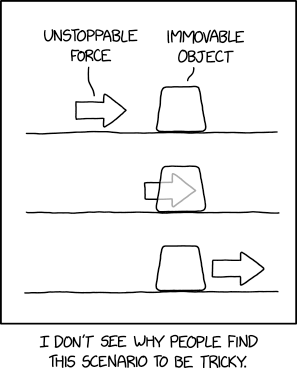this post was submitted on 02 May 2025
800 points (98.3% liked)
xkcd
10698 readers
15 users here now
A community for a webcomic of romance, sarcasm, math, and language.
founded 2 years ago
MODERATORS
you are viewing a single comment's thread
view the rest of the comments
view the rest of the comments

I think if God creates a rock so heavy he can't lift it, it's probably a black hole. By definition we can't know what happens inside a black hole, because no information escapes the event horizon. As it's now consistent with known physics that we can't know many aspects of this interaction between God and the black hole, I think this paradox is basically solved. We don't know any more about the interaction, but it's no longer a paradox, it's consistent with physics.
Actually, the new theory is that the hawking radiation exfiltrates information from inside the black hole via quantum entanglement. Of course, it hasn't been tested yet for obvious reasons.
But black holes have finite mass. By "heavy" you're implying it's infinitely heavy or something.
You can definitely also lift a black hole.
Well I don't know about any objects more massive than black holes. I think a black hole is really the only viable form a body can take once there's enough matter in one place, like there's an upper limit for the size of stars and after that anything larger collapses into a black hole.
An object of infinite mass is a contradiction, a universe can't exist with a single object of infinite mass, it would consume everything instantly.
OK, but being very massive is not the same as what was being discussed.
You can also "lift" a finitely massive black hole with anything else massive.
Are you sure? I mean the word "heavy" was what I was going on, but there is a distinction I suppose.
Yeah, that's true... But again, I do have to stress that there is no alternative to "finitely massive" you really can't have an object of infinite mass in our universe.
Edit: So I guess it comes down to this: If "lift" and "move" are synonymous, then anyone can move any object of finite mass. An object of infinite mass can't exist in this universe. So you could say that the answer to the question is definitively no, God can't create a rock so big that he couldn't lift it, at least not given the laws of physics in this universe as he created it. (For this conjecture we're assuming God exists and created the universe).
If God created this universe he could in theory also create other universes with different laws of physics. So in that case, sure, why not, who knows.
It may be worth it to decide how we define ‘unstoppable force’ and ‘immovable object’.
An Immovable Object has 0 velocity:
v = 0
Acceleration is the time derivative of velocity:
a = d/dt(v(t))
a = d/dt(0)
a = 0
And we know that
a = F~net~ / m
An object with infinite mass would satisfy this equation, but an object with no net force would too. We could add a correction force that will satisfy the constraint of 0 net force.
|F~net~| = 0
∑F~i~ = 0
F~correction~ + … = 0
To satisfy Newton’s 3rd law, we would need a reaction force to our correction force somewhere, but let’s not worry about that for now.
A physics definition of ‘Unstoppable Force’ is:
|F~unstoppable~| =/= 0
In this case the gravitational force fits this description, given a few constraints
F~g~ = Gm∑ M~i~ / x~i~^2^
As long as the gravitational constant G is not 0, our object has mass, and
∑ M~i~ / x~i~^2^ =/= 0, then
|F~g~| > 0
But this does feel kinda like cheating because it’s not really what people mean by ‘unstoppable force’. the other way to define it is just immovable object in a different reference frame.
a = 0, |v| > 0
I’m gonna stop here because this is annoying to type out on mobile